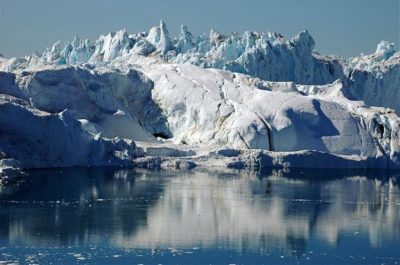A melting glacier in Greenland that serves as evidence of global warming isn’t actually melting at all.
 Over the last few years it’s actually been growing, according to new research.
Over the last few years it’s actually been growing, according to new research.
A study published in Nature Geoscience shows the Jakobshavn glacier is now growing at about the same rate it was shrinking just six years ago, when it was retreating by about 1.8 miles and thinning by 130 feet per year, the New York Post reports.
The study’s lead author, NASA glaciologist Ala Khazendar, contends the ice growth likely stems from a natural cycle of cooling and warming in the North Atlantic Ocean known as the North Atlantic Oscillation.
Water temperatures in Disko Bay, where Jakobshavn meets the Atlantic on Greenland’s west coast, are now about 3.6 degrees cooler than in the past, but scientists argue the temperature swing is evidence climate change could occur more quickly than previously thought, according to NASA.
Josh Willis, a NASA climate scientist and co-author of the study, said the water cooling and corresponding ice growth shows ocean temperatures are a bigger factor than most scientists realized.
“Jakobshavn is getting a temporary break from this climate pattern. But in the long run, the oceans are warming. And seeing the oceans have such a huge impact on the glaciers is bad news for Greenland’s ice sheet,” Willis said.
“In the long run we’ll probably have to raise our predictions of sea level rise again,” he said.
The new research comes a decade after Al Gore told a Global Climate Change conference in 2009 that experts predict there’s a 75 percent chance the entire north polar ice cap could be “completely ice-free within the next five to seven years.”
Scientists studying the Jakobshavn Glacier, “Greenland’s fastest-flowing and fastest-thinning glacier for the last 20 years,” were shocked when it began to grow as the natural water cycle in 2016 brought ocean temperatures down to some of the coldest in 30 years, NASA reports.
“At first we didn’t believe it. We pretty much assumed that Jakobshavn would just keep going on as it had over the last 20 years,” Khazendar said.
Essentially, colder weather changed the glacier’s pattern and scientists are attributing it to a temporary North Atlantic Oscillation, which they assume will return to a warm phase and continue to melt Jakobshavn in the future.
Whether or not that actually happens, NASA scientists believe the new study – “Jakobshavn’s 20 Years of Acceleration and Thinning Interrupted by Regional Ocean Cooling” – will help to better predict how ocean temperatures impact glaciers, though it’s clear the massive ice won’t be disappearing any time soon.
The Jakobshavn researchers “deployed new technologies that allowed us to observe a natural experiment, much as we would do in a laboratory, where variations in ocean temperatures were used to control the flow of a glacier,” said NASA scientist Tom Wagner, who was not involved with the study.
“Their findings – especially about how quickly ice responds – will be important to projecting sea level rise in both the near and distant future.”
Leave a Comment
COMMENTS POLICY: We have no tolerance for messages of violence, racism, vulgarity, obscenity or other such discourteous behavior. Thank you for contributing to a respectful and useful online dialogue.